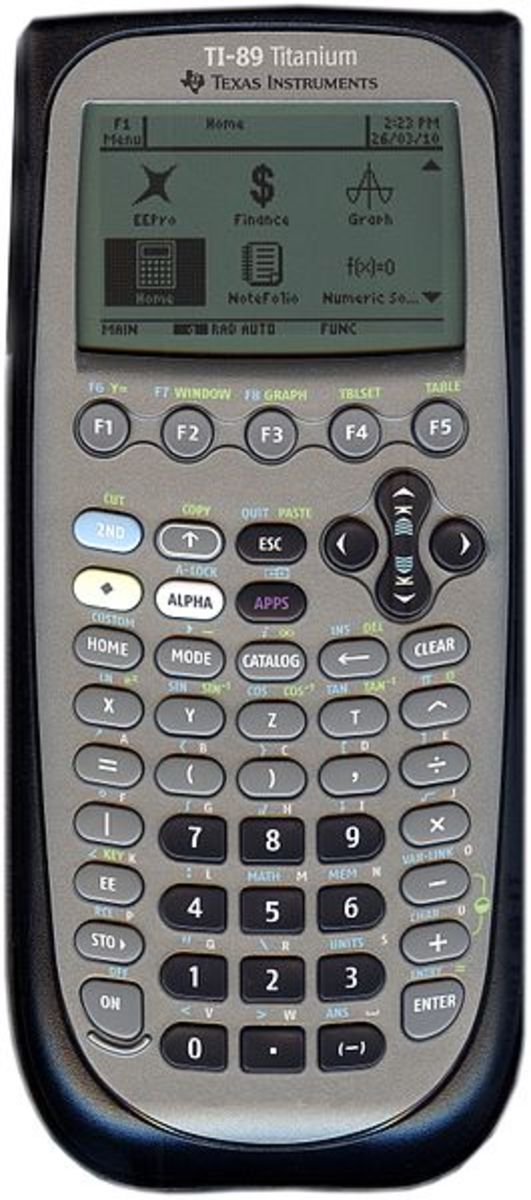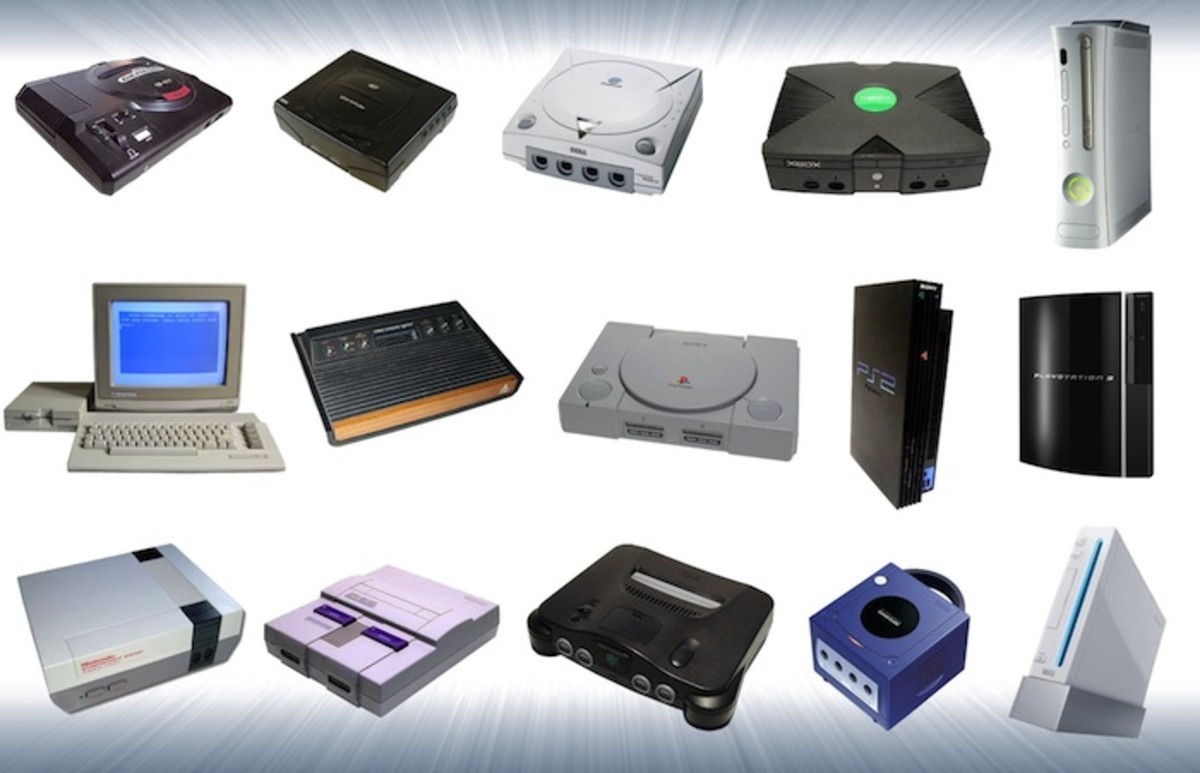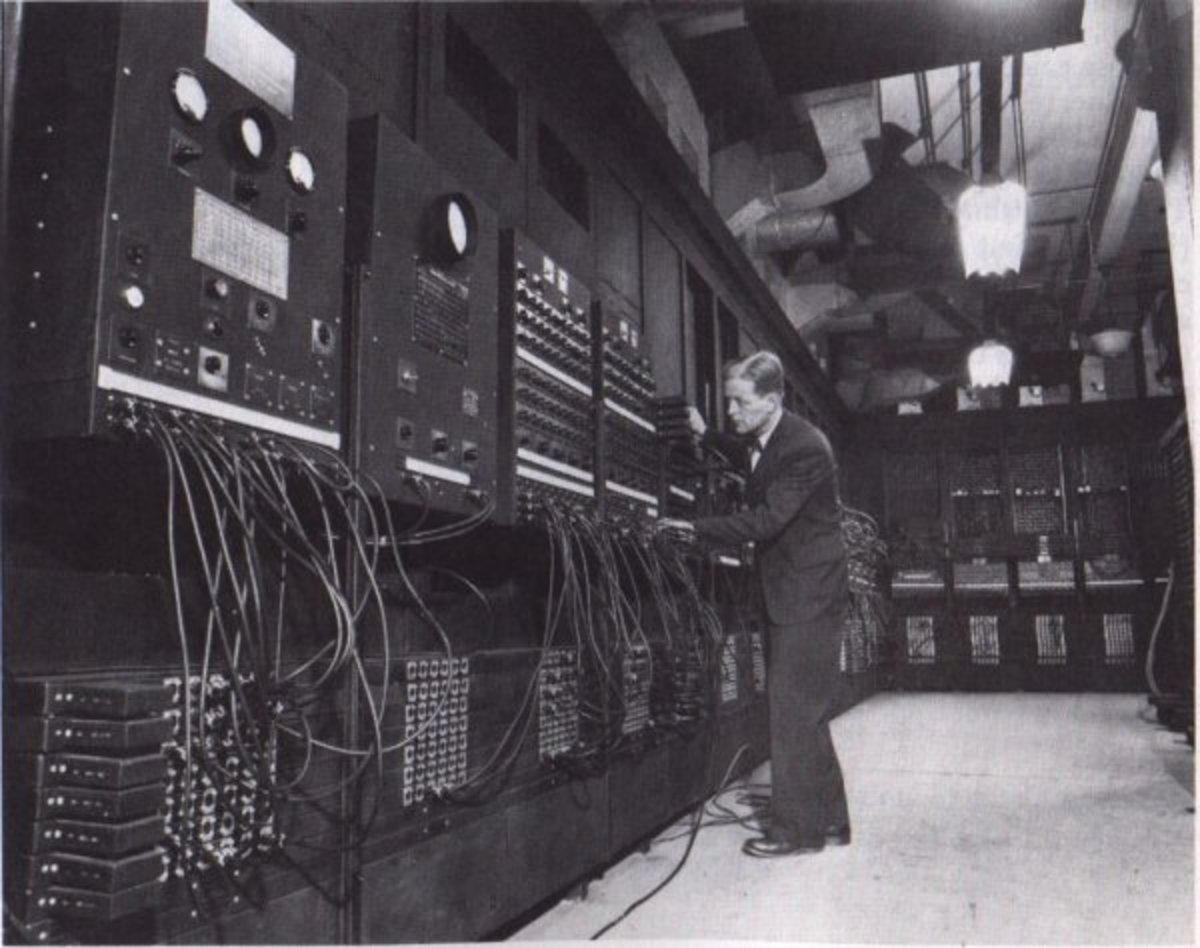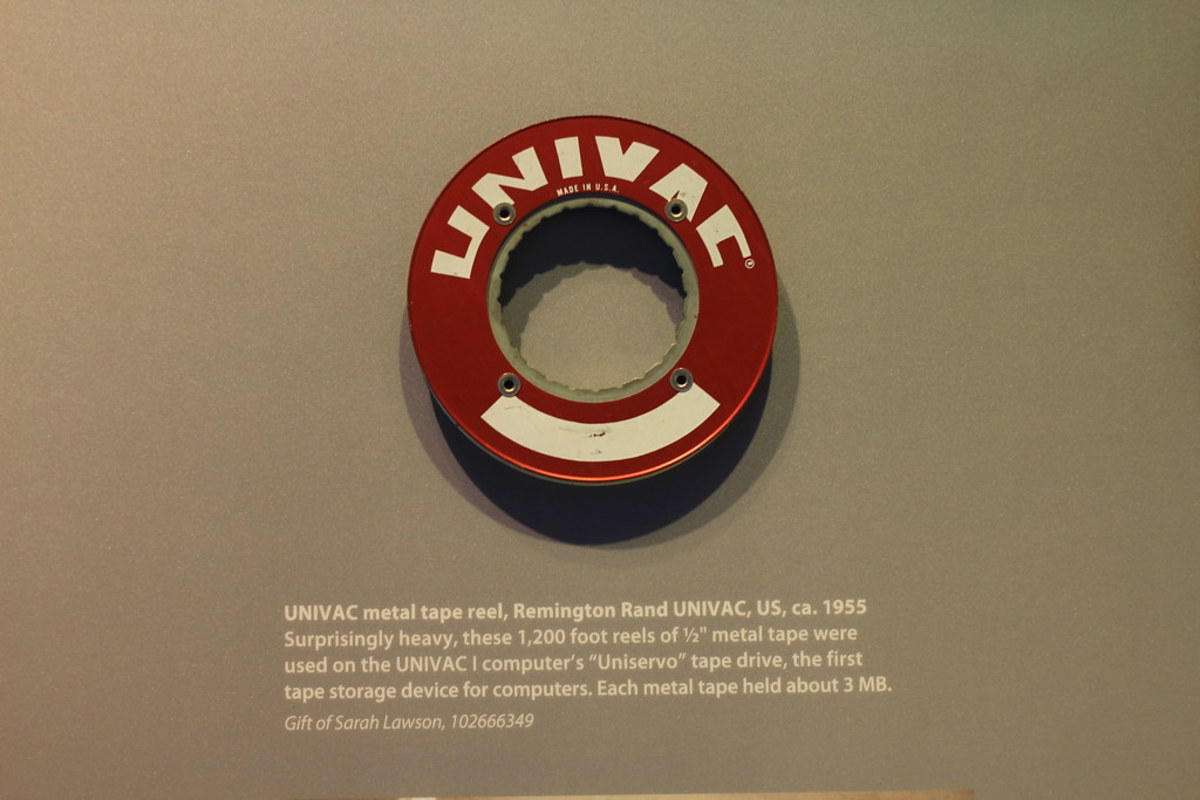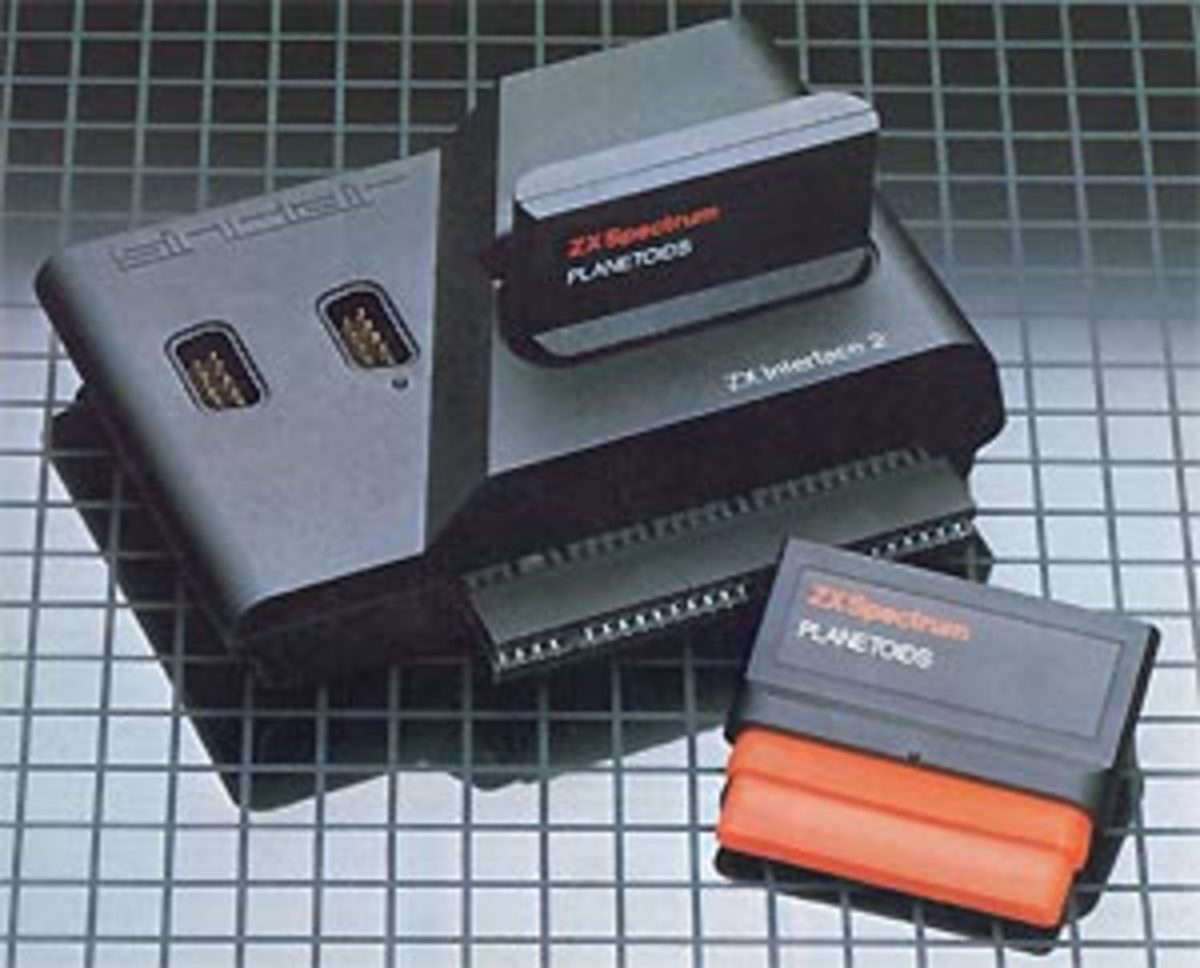The Best Computer Games Ever
The Blurb
Surprisingly, I have a lot of gaming experience. I have owned and played loads of consoles, arcades and home computers over the 25 or so years – I was literally brought up in front of a ZX81, thanks to my father who shared a passion for early gaming. I could at this point reel off the list of formats that I have owned, but it’s not important.
What IS important is the games that these formats have offered, and it is never as simple as “the most powerful console equals the best games”. In fact, it is now becoming more obvious that great graphics do not equal a good game; however, graphics is always the first point of call for any marketing department to focus on when advertising a game, so it is very easy for the normal consumer to associate good games with good graphics. A very recent example is the non-HD Wii console taking the Xbox and PS3 to town because the games are simply that much more fun. However, this all depends on your ilk. I couldn’t imagine playing a First Person Shooter on the Wii (in fact, I did buy Call of Duty 3 on the Wii, which was terrible thanks to an awful control system), but equally, can’t imagine anything like Brain Training on the PS3. The old maxim, “Horses for Courses”, is very much applicable at the moment.
With competition comes comparison, and I have read a lot of other people's opinions about the best games. I find them too "new", or too biased to a certain genre or platform. Well, time to put my money where my mouth is and start a list of The Best Games Ever!
Below is an ever-expanding list of the best games ever to be released on almost all formats. If you have a suggestion, please comment at the very end.
Grand Theft Auto
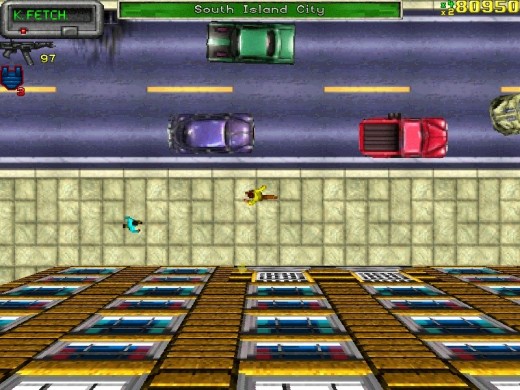
Grand Theft Auto - IBM PC
I remember GTA because it was one of the first games to take advantage of the newly-released Voodoo chipset. GTA was excellent because of three reasons; one, it was set in multiple large cities with plenty to do. Two, there were many missions to accomplish and had a lot of gameplay behind it. Three – you could steal cars and cause lots of mayhem with guns and flamethrowers.
It was a top-down affair, looking down (apparently) from a helicopter hovering above the city. You gained the trust and hatred of the various gangs in the city by answering telephones and performing the tasks that they ask. You had pretty-much the key to the city; race round the roads in sports cars, or run over pedestrians , or take a police car, or ride the train… it was as varied as it was massive.
I’m not always a fan of rating a game on graphical ability alone, but the difference between the DirectX “normal” version and the Voodoo version was astounding. The only other game of note that had a dedicated 3DFX version at the time was Carmageddon; must be something to do with running people over in cars I suppose.
Anyway, GTA was followed by a second similar title and a London version. This format was changed to the one we are now familiar with in GTA3 (an awesome sequel) and GTA4 (too slow to be fun).
Deus Ex
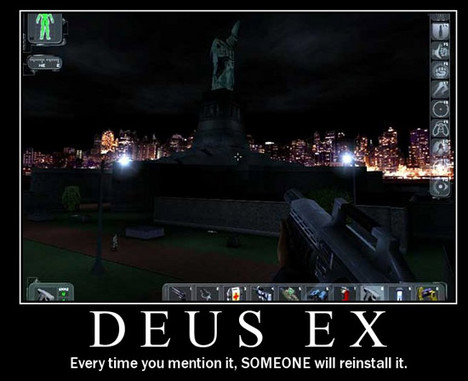
Deus Ex - IBM PC
I wish I could remember how I came to purchase certain iconic games, but in this case, I can’t. All I remember is playing through what seemed like a run-of-the-mill FPS shooter, then all kinds of a role-playing game started to come through hot on the heels of an intriguing plot and many different customizations for weapons and your own body. It was on the 3rd level that I started to get that “I’m playing something special” feeling; there have been many games on the PC that try to bind together an FPS with an RPG, such as System Shock 2. However, they always fall short by being too linear, which counteracts the point of being a role-playing game. Deus-Ex gives the player an extremely wise berth, to either choose appropriate upgrades or just try to battle through the game.
You play as JC Denton, a UNATCO agent that is physically enhanced by nanotechnology. You start off by battling apparent terrorists, but then start to discover a deeper governmental conspiracy concerning the now-rampant Grey Death virus and its controlled vaccine. Most popular conspiracy theories make an appearance, such as the Men in Black, Grey aliens, and mutated animals.
This game has a very capable control method, good graphics (which, happily, does not alienate older systems), and a surprisingly interesting plot. It’s the depth and scope of this game that makes it an essential title; I defy anyone not to enjoy it.
Unreal Tournament
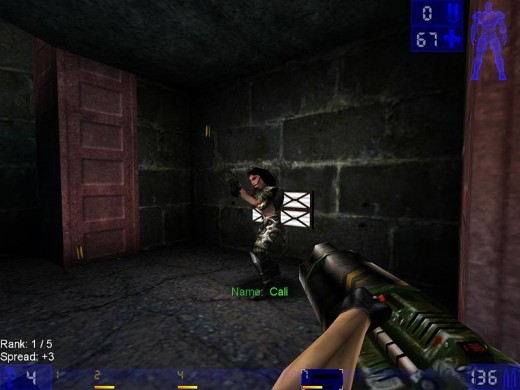
Unreal Tournament - IBM PC
I remember buying the original Unreal, and being suitably amazed by it; the landscapes! The strange but functional weapons! Those weird octopus-things hanging from the ceiling! And, of course, the bot matches. This was the first game that I can remember that simulated a multiplayer experience with bots. It was very good, and a precursor to Unreal Tournament. At this point, I should mention Quake 3 Arena. Q3 definitely had the graphical advantage, but UT had some very well-presented levels, some of which have achieved multiplayer cult status. Quake 3 was more frantic though, which you either loved or hated.
For its time, Unreal Tournament was unusual as it didn’t have ANY plot to it; you battled against a number of opponents, and moved onto the next map. Nowadays, it’s hard to find a FPS with a single player plot to it – look at something like Left For Dead.
In terms of the gameplay, Unreal Tournament felt right. The weapons were extremely versatile, especially since there were usually two firing modes to each. I was always a Flak Cannon man myself, but loved using the Shock Rifle to take people out at longer ranges. My friend was a rocket launcher and sniper rifle fan, and my other friend was a bit of a demon with the blob gun, somehow. It was frantic, fun, the maps were interesting and required some tactical play, and all-importantly, it was that bit-more technical than Quake 3 Arena. Come get me Quake fans!
It is worth mentioning thatt here have been a few sequels to Unreal and Unreal Tournament; although extremely good and include vehicles (on-par with Tribes II), they cannot touch the original UT for pure arena deathmatching.
Killer Instinct
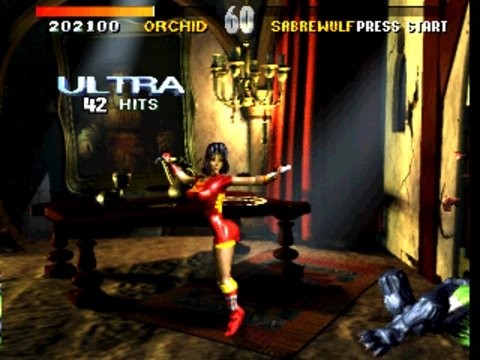
Killer Instinct - SNES
There are only three fighting games that matter; Street Fighter 2 (provided the basic strategies behind one-on-one fighting games), Mortal Kombat (brought the blood and guts of fighting games to the screen), and Killer Instinct. The main problem behind Street Fighter 2 and Mortal Kombat is that playing a "button-basher" opponent can be frustrating, and sometimes resulted in "odd-results", for want of a better word without saying "losing". Killer Instinct changed that. It demanded finesse, tactics, and practise. A button-basher will NEVER win on Killer Instinct because it requires each player to know the character's moves and their combinations.
Talking of characters, they were a little off the beaten track, but not nearly as "unholy" as MK's cast. You have (to name a few) a cyborg, a wolf, a skeleton, and a boxer; all examples of evil. The moves are along the same lines as other fighting games; fireball movements and charging moves. Orchid's character was a little bit...enhanced in certain areas, but I suppose Lara Croft built a following because of the same reason.
In simple terms, think Street Fighter but with the ability to chain moves together and finish them like Mortal Kombat. It is possible for the other player to "combo-break" a combo in progress too, so it isn't a case of getting the first shot in. I loved KI, but it is not for everyone.
Xybots
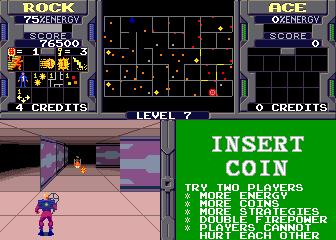
Xybots - Arcade
Xybots came out in an era where Atari battled with Sega to rule the coin-operated arena. Xybots was a little bit special since the joystick could twist in order to turn the character 90 degrees. It was all good; robots, guns, mazes, power-ups, coins. At times, you could be surrounded by robots all trying to blast you from 4 different directions. The map at the top of the screen helped navigate the sometimes intricate layout, but unless you purchased the Guardian option, you could walk face-first into a hidden robot, so you were forced to keep alert at every turn. The power-ups also added a dimension of strategy, especially when running low on coins; do you buy the map for the next level or an enemy mapper?
Couple this with a 2nd player who worked independently from your screen, you could both roam the maze killing anything metal (or each other after the first couple of levels). One of Atari’s greatest moments. Ported well over to the Atari Lynx, but other formats simply couldn’t pull the true feeling of the game off.
Tetris
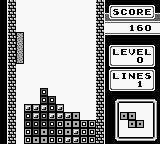
Tetris - Gameboy
Back in the day, console makers were an odd bunch; their reasoning was that people would be more likely to buy their console if there was a game bundled with it – a GOOD game that you couldn’t get on the other consoles. It was a chance to make a unique game for the format; much like a wrestler’s trademark finisher. Nintendo chose Tetris, and people in turn chose the Gameboy. Incidentally, look at the Wii and Wii Sports…
I am unsure how to introduce this; everyone knows Tetris, even if not on the Gameboy. What marks the Game Boy version out from the arcade and other console versions is the clean simplicity of the graphics. Stack the bricks together in monochrome. The format suits the game, and vice-versa. Being a portable system too, you could pick it up, play it, put it away again.
For a short time, the Tetris format was picked up and milked; I remember the awful Wordtris, Super Tetris, Tetris 2... all pretty lame and pointless. There may never be another game quite like Tetris on the Game Boy, and in a weird way, I hope there never is.
Treasure Island Dizzy
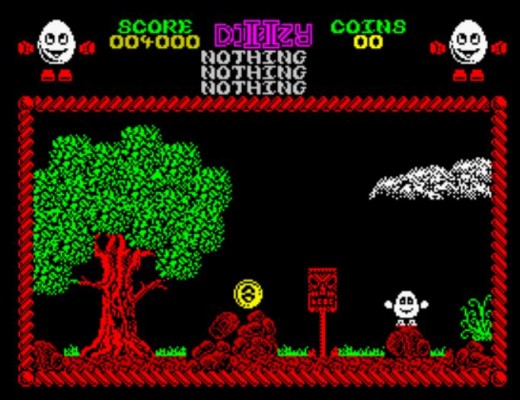
Treasure Island Dizzy - ZX Spectrum
Dizzy wasn’t a character that had a lot of potential, but Codemasters did try to get him to iconic status. There were 7 Dizzy adventures (can be argued that there were more due to “composite ports” to some later consoles) plus Bubble Dizzy, Dizzy Panic and Fast Food too; not that I had a Spectrum or anything... The first Dizzy adventure was a quiet affair, collecting items and talking to characters. However, the second outing is where Codemasters got it so right, with lots to do and a good adventure plot.
Incidentally, I chose the Spectrum version because it was the only version, with its massive 128kb of memory (!), that delivered a good balance of sound, graphics and continuity. For example, the Commodore 64 version would reset the position of the underwater hazards (jellyfish) when you moved to another screen; the Spectrum version didn’t and would move them irrespective of whether you were on the same screen as them or not - high technology!
Anyway, you control Dizzy the egg, who has been washed up on a desert island. Collect the coins hidden behind objects, and try to leave the island using your jumping skills, various objects and quick-thinking whilst avoiding the traps on the island. It has a very unforgiving margin of error; fall into one trap, and you go right back to the start of the game. I did end up clocking this game, and a fair while it took too. Simply massive for the Speccy, and great fun too. Proof? Although the Spectrum is commercially dead, Codemasters won't allow the public distribution of ANY Dizzy adventures on this platform. Hmm.
Super Mario 64 - N64
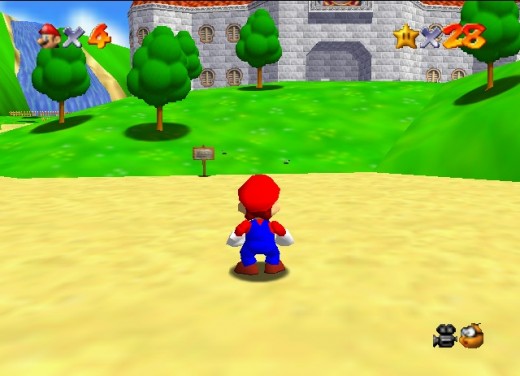
Super Mario 64 - N64
Question; you have the next generation console in your family of machines about to hit the consumer market. How do you make a statement about it? Answer: you release the most popular game on your previous console, but in 3D.
Super Mario 64 was possibly the most important game in console history ever. Sure, Mario had been released on ever-increasingly powerful machines, but always as left-to-right scrollers. Yoshi’s Island was the last word in this genre, and with the N64’s impressive specs, something more was needed. SM64 was thus created and it was a screamer, set in a large 3D environment and boasting awesome graphical effects for a console; there wasn’t much on any other format that could touch it for sheer depth of gameplay and graphics. You see, Mario 64 also showcased the potential that the N64 had. Chrome reflections? No problems. Hundreds of polygons shifting around the screen? Easy. Full stereo sounds that don't sound crackly AND not just playing off of a CD (ahem Playstation ahem)? Got it.
It was a little harder to control Mario than in the 8-and-16bit outings, as the analogue stick required precision control. People got a little confused when the camera shifted viewpoint whilst walking, but in a way, this was a blessing; once you had Mario 64's controls under your belt, it set you up for future N64 games and their controls.
I'm not sure which came first; Tomb Raider or Mario 64, as both brought the 3rd person 3D adventure format to the gaming market. However, Mario 64 was the more superior because of the variety of the puzzles and tasks. In a sense, it could be argued that Mario 64 dipped a pinkie into the RPG area too (although legions of WoW fans will surely beat me senseless over this last sentence) in terms of the "quests" you had to do, although there was no character development throughout the game. Regardless, Mario 64 is definitely one of the best games ever released, and if you have a Nintendo DS, I would strongly recommend going and buying yourself a ported version of greatness.
Time Crisis
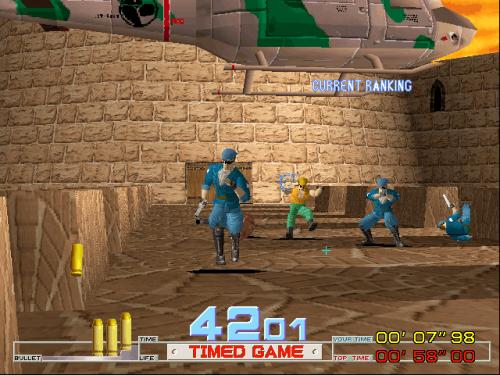
Time Crisis - Playstation
“Action!” Home consoles and light-guns have had an unsteady relationship. Truth be told, they never worked that well and had limited appeal. Now look at the state of affairs; the Wii is practically light gun controllers as default. The only place light guns were truly at home was in the arcade, so games like Operation Wolf, Space Gun and Terminator 2 stayed in the arcade (these games came out on home machines, but not as lightgun games, which was odd). Time Crisis in the arcade was brilliant; you played as a special agent fighting his way through areas of enemies that would pop out of hiding, or jump into view from ropes. The unique thing about TimeCrisis was that you could choose when to duck into cover and come out of hiding via a foot pedal. When you went into cover, you couldn't shoot but you couldn't get hit either, and you could only reload when in hiding. Finally, you had a finite time to finish the level. You could accumulate time by finishing a section, so your quick-firing skills were tested too.
The Playstation version was absolutely spot-on; it came with a lightgun, and you could use a second pad as the footpedal if you wished, although this did result in your precious spare pad smelling of cheese - trust me on this. :-) Otherwise, a small button on the bundled gun done the job of ducking. Since the Playstation version was a complete version, you could find out those little shortcuts (such as blowing up the canisters on the fork-lift in the first section) and then look cool at the arcades. If such a thing is possible. Top marks.
Goldeneye
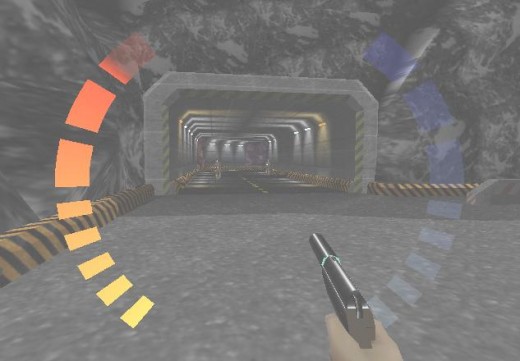
Goldeneye - N64
Games that are based on films are generally rubbish. However, Goldeneye was exactly what the N64 needed at the time to establish itself as a serious gaming platform. Sure, armed with its 64-bit processor and SGI graphics chip, the N64 could do wonderful things, but the Playstation was offering games like Wipeout; adult-aimed offerings, rather than the cartoon-ish Super Mario 64.
Goldeneye changed that. The N64 slapped its mighty fist down on the gaming table and gave the Playstation something to worry about. The N64’s analogue stick (the Playstation didn’t have the dual stick pad at this point) allowed aiming to a precision on-par with the PC (and, for the real connoisseur, a two-pad control method). The game followed the Bond film almost to the letter, but that wasn’t any bad thing. Using a good selection of different weapons, the game was a brilliant first-person shooter and challenged even the most seasoned FPS player.
BUT. Goldeneye brushed away all competition with its multiplayer mode, allowing up to 4 people to run around blowing each other up in a mixture of ways, on the same console. At the time, it was unique, and possibly the best multiplayer experience at the time.
Slick graphics (toned down when playing multiplayer, but not to the point of distraction) and pretty good AI in single player mode make this one of the best FPS games ever, and possibly the best splitscreen multiplayer game ever, although Call of Duty 4 may have picked up the crown on this point.
As an aside, Rare’s next FPS game on the N64, Perfect Dark, should have been the ultimate (slightly nerdy Ultimate/Rare pun there), especially with a gun that allowed you to snipe anyone from anywhere on the level. However, it just didn’t flow as well as Goldeneye, and faded quickly into history (although there has been a Perfect Dark Zero released on the Xbox 360, which is about as plain as vanilla can be).
Space Harrier
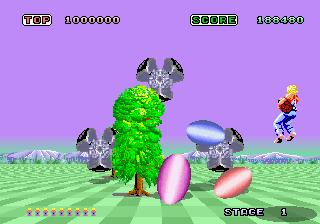
Space Harrier - Arcade
Back in the late 80’s, there were two ways to clock arcade games; play well or pay well. Space Harrier certainly falls into this bracket (hand in hand with Afterburner). Get this; you control a flying man with a proton cannon tucked under his arm, for some reason facing off against anti-gravity rocks, stone faces, two-headed dragons (and a guest appearance from the luck dragon out of Never Ending Story), robots, jump jets and other strange enemies, seemingly inspired by Dali. Pretty sweet, huh? Well, for one, the game is unique; the sounds are wacky and unusual, the graphics are awesome for the time, and the gameplay is furious, fast and unforgiving. There is no plot; it’s simply an action blaster, and that is the charm of the whole game; an adrenalin buzz. It was very well-suited for the arcade market, as it required little familiarity in order to play it, but was unbelievably difficult after stage 4. There was a movable "cockpit" version in the arcades which was an awesome experience.
Shadow Squadron
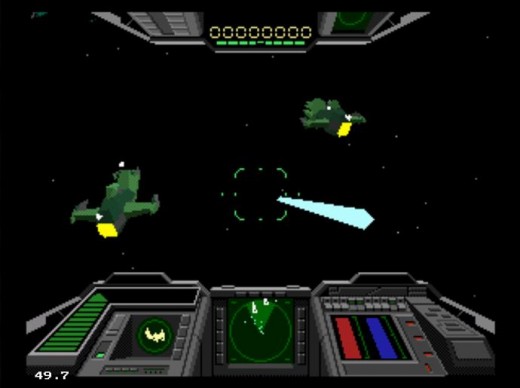
Shadow Squadron 32X - Sega 32X
The what?! For those that are unfamiliar with the 32X, it was a special add-on for the Sega Megadrive that turned it into a 32-bit machine. Most developers treated it like a Sega Super FX chip and brought out a whole load of polygon-based games, although the 32X allowed for a very very good port of Doom.
Shadow Squadron was a very well-presented offering, a 3D space combat sim that could be played in two very different ways depending on your choice of ship. The first was a fixed-frontal weapon but allowed for multiple lock-ons. The second was a turret-based fighter which was really for two people; one steered, the other operated the cannon. Whether you went solo or with a partner, you ended up fighting a whole fleet of spaceships, from small stub fighters to massive capital ships. Each level required you to either clear out the sector or destroy some ridiculously-large structure without getting blown up. Even for the relatively archaic 3D technology, it was engrossing and, as long as space combat sims are your thing, I can't find a single thing wrong with it.
Final Fantasy 3
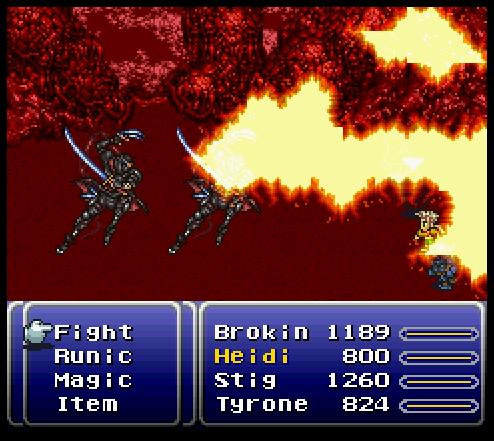
Final Fantasy 3/6 - SNES
I hated Final Fantasy 7 with a passion. It was very slow in terms of getting to the meat of the action, the 3D viewpoint didn’t work too well when trying to go up and down narrow stairways, and was generally over-hyped mostly due to all the new gamers (courtesy of the trendy Playstation) thinking that nothing like it had ever been made. Excuse me and make room for Final Fantasy 3, a true king amongst men.
Final Fantasy 7 owes a lot to Final Fantasy 3, especially the fight mechanics which are almost identical. FF3 has a much more gripping storyline, and feels more substantial that FF7. It’s not exactly turn-based, but not exactly real-time combat either. You could argue that the 32-bit PSX delivered a more anime adventure experience, and that FF7 is better as a result. No; the 16-bit SNES, without all the pomp and circumstance of a CD-based system, delivered a better RPG game.
The depth of the game is awesome; you have different heroes to control, you can collect many different ethers (creatures that can be called upon to smite your foes) and kit out your heroes with numerous weapons and items. The plot is one that will feel familiar with RPG veterans; evil forces must be stopped, etc etc etc. I always liken it to a more serious Zelda but with a Manga-kick for good measure. The fights become an artform, trying to decide which ethers to use with who and what weapons to give. Some areas are absolutely solid, whereas some areas become a nuisance from low-level enemies pestering you.
Do yourself a favour; chuck out your PSX, dig out your SNES from your attic, buy FF3 on eBay and take a week off work.
Star Wars
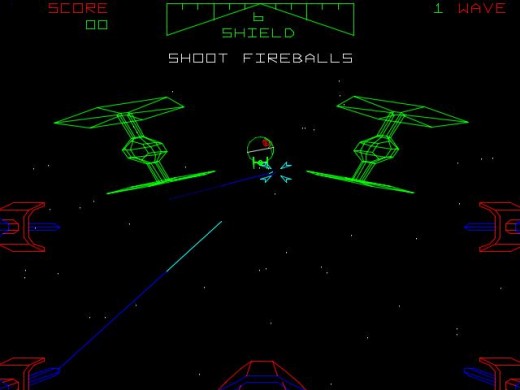
Star Wars - Arcade (80's)
Escapism at its best, Star Wars Arcade was probably made in order to give the majority of movie-going male teens the chance to live out their fantasy in the 80’s – to be Luke Skywalker and blow up a planet-sized base. I remember playing this in a huge cabinet, joystick and all, and it was ace.
Basically, this game is set within the last 15 minutes of A New Hope; attacking the Death Star. Tie Fighters attack you relentlessly, until you dive down into the Death Star for the trench run. There, you need to shoot fireballs and avoid obstacles until you get to the port exhaust. Fire some funky torpedos into that, and the death star explodes. End of game? No, repeat ad infinitum until you die.
Zelda - Link's Awakening - Gameboy
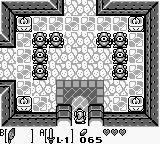
Zelda Link's Awakening - Gameboy
I bought this on a complete whim when it came out; I wasn’t a fan of the Zelda series on the NES, but my Game Boy was needing a new game (and I had just sold a 25-in- cart to a friend for 25 pounds, not that I condone piracy in any way, shape, form or fashion). It turned out to be possibly the best decision of my life, as Zelda somehow became a part of me.
What distinguishes this Zelda adventure against and above the other outings is the sheer depth and presentation of the whole game. Consider that the Game Boy was simply an LCD game unit with interchangeable cartridges, Nintendo managed to squeeze hours of play into such a small footprint and, incidentally, took such care over the shading of the graphics that the monochrome colour wasn’t noticed. The soundtrack was brilliant, and suited the atmosphere of any particular level perfectly. When I finished this game (no easy feat, and this was pre-Internet, "I'll just go onto the web and look up the answer" gaming), it felt like a dear friend had left me. It was a journey, and I enjoyed every step along the way.
There will be many people who disagree with this and state that the SNES or N64 adventures are superior to this. Sure, graphically they are superior. However, they lack the spirit and care that is obvious in 'Awakening (and I have been bitterly disappointed by both the Wii and DS Zeldas). The SNES did come very close, but despite the technical handicaps that the Game Boy had, Zelda has never been better.
Street Fighter 2 Turbo
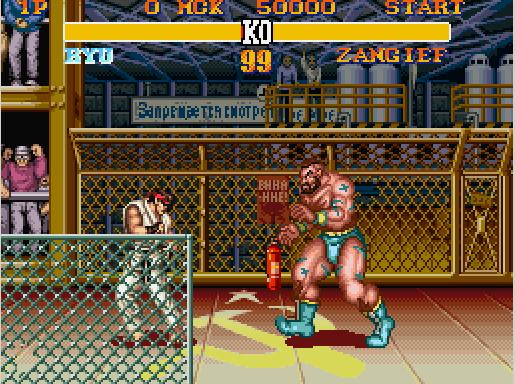
Street Fighter 2 Turbo - SNES
A few months back, I was sat in a Thai restaurant with some work associates, when computer games came into the conversation. A few old favourites were discussed, laughed at and dismissed. Then I brought up Street Fighter 2 Turbo, and everyone changed. Everyone started reminiscing moves, characters, experiences (my favourite was a long-lost friend who would smash his pad in frustration when he lost, to the point where his pad was completely wrapped in black gaffer tape).
The original Street Fighter wasn’t worthy of being a prequel to SF2, and how the game evolved from 1 to 2 is simply mind-boggling. People literally went insane for SF2, to the point where it didn’t matter what format you were playing it on – you were playing Street Fighter 2. Incidentally, the funniest version was the ZX Spectrum; you had to load in every character separately, running the whole tape from start to finish until the right character’s code was found. Also, all the moves weren’t present and it moved so slow that you were unsure whether the computer had frozen up or not.
Anyhow, the SNES version pips all other versions because of the SNES pad and the absolute accuracy of the port to the console. Each character had its pros and cons, and there was a character to suit any player; even some button-bashing, always-jumping characters for your sister and mum. The graphics were smooth, colourful and responsive. The music and sounds were perfect for the game (even the digitized speech was good), the backgrounds were interesting, and the number of moves numerous and challenging to master, let alone how to integrate them into a lethal attack.
For added extra “mystique”, the 4 bosses somehow swapped names halfway across the world, so European players were at odds to USA and Japan. People speculated that the reason was because M. Bison was too much of an obvious dig at Mike Tyson, but I can’t see how a slight hint could have threatened any kind of legal action. In any case, the game was and still is perfect. Later versions started to expand the Street Fighter storyline unnecessarily with characters, to the point where you have too much choice, thus cheapening the characters. With Street Fighter 4, this trend has suddenly been reeled back – good news, but still lacks something from 2.
Fable 2
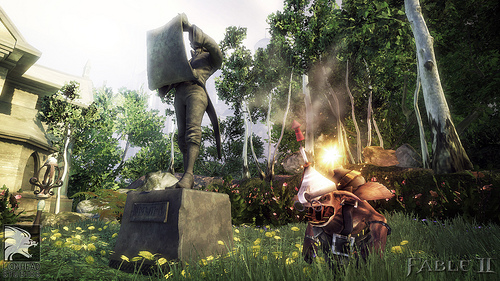
Fable 2 - XBox 360
I am a veteran of many RPGs, and I did harbour doubts about the suitability of making a large RPG on a console. You need keys, and lots of them to control your character/map items for quick use. You need a mouse for precision movements and menus. You need, basically, a PC. One day, Fable on the Xbox arrived and changed my mind. It was great. A large adventure with many missions, a slick interface, a good storyline and an interface that worked well on a joypad. My one huge disappointment was that the end was just that – the end. So many missions not done! So many sights unseen! The PC version of Fable did readdress this, but it meant retreading old ground.
Fable 2 took the original Fable, polished it up in glorious HD, stuck in a “diamond in the rough” storyline, and gave the player a dog to help gnaw on some enemies. The world is huge, but not to the point where you feel lost (Oblivion?). There is one strange thing about Fable 2; you cannot die. Although you’ll never get that sinking feeling when you die without saving 4 hours’ gameplay, it does feel like you have a God cheat activated. However, the actions you take in terms of interacting socially with the AI characters can make or break the game more than not dying. You can treat people well, make them laugh and buy them gifts, or go wading into each village with an axe. Either way gives you a different game experience. Also, get a pal to grab another pad, and you suddenly have a real-life sidekick to fight alongside you.
There are so many ways to play this game. Plus, once you complete the main mission, you can live out the rest of your character’s life buying property, doing the smaller side missions and generally living out an honest or evil existence. A modern classic - too cliched?
Sonic 2
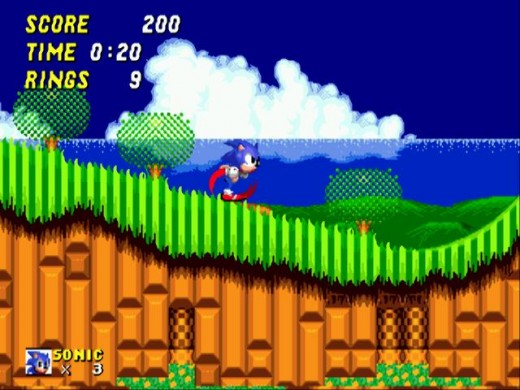
Sonic 2 - Megadrive/Genesis
Nintendo had Mario as their flagship character, Sega had Sonic. The Mario vs Sonic argument was as old as the SNES vs Megadrive one, and Nintendo won. However, Sonic’s second appearance on the Megadrive (Genesis for you Americans) is Sonic’s best adventure .
Firstly, the Megadrive’s hardware wasn’t as spectacular as the Super Nintendo. Graphics were slower and capable of displaying less colours, the processor was an older and weaker Motorola chip, and there was less RAM on-board. However, the Megadrive was somehow tortured into making Sonic blaze around the glorious landscapes effortlessly, unless you got hit when carrying more than 30 rings.
Secondly, Nintendo had established Mario as their character years before Sonic had made an appearance, and Sonic was fast becoming an emulation of Nintendo’s idea; rings instead of coins, left-to-right platformer, a time limit per level…etc etc. Instead, Sega distracted from the obvious operational similarities with Mario by making a high-paced, acrobatic side-scroller that didn’t have sharp edges like the blocks and pipes in Super Mario Bros. Instead, the levels were smoother, and incorporated deeper parallax scrolling backgrounds. Finally, a second character was thrown in for good measure (and to give a friend or sibling something to do if they wanted) in the guise of a two-tailed fox.
All in all, Sonic 2 refined the first Sonic game and is still the superior game compared to the later adventures. Sonic 3 was much-anticipated, but failed to capture the solid presence and break-neck speed that Sonic 2 had established. Adding more obscure creatures as “pals” wasn’t necessary and, unfortunately, Sega completely misread Sonic’s appeal.
Doom
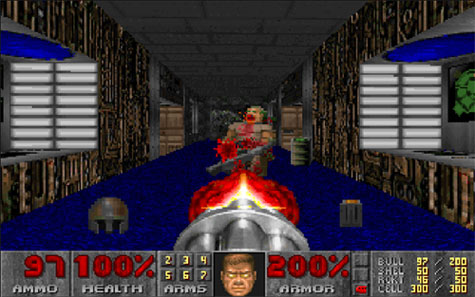
Doom - IBM PC
Ah, Doom. It changed computer gaming forever. It bounced the PC to the very top of the gaming platform. It introduced the concept of shareware to the games industry (the shareware version of Doom is bigger than most modern games in terms of hours of potential gameplay). It made people suddenly take notice of computer games; a lot of people who owned Doom-capable PCs were in the 25 to 40 year old bracket, an area previously not targeted by console/game manufacturers. It made the shotgun a legendary weapon. Finally, it brought the first-person shooter genre into the arena, for all to admire and emulate.
The game was HUGE, dark, and violent for its time. It’s 3d perspective viewpoint was a refined version of one that was used for Doom’s predecessor, Wolfenstein, but the additional details, speed, and sound required cutting-edge hardware for the era. Ideally, a 386 DX (co-processor) 33Mhz processor, 4Mb of RAM, 14Mb of hard disk space and a Soundblaster multimedia soundcard was needed to get the best out of Doom. It was SO worth it though.
If you’ve never played Doom, you need to before you can appreciate the modern-day FPS games. Important concepts were introduced in Doom, such as weapon variety and environmental dangers; the exploding barrel was a very important weapon, but one that could also become your worst enemy. It also introduced multiplayer deathmatch; connect two computers through their serial COM ports, or “null modems”, and you could fight against each other (and later via TCP over a network) or fight the legions of Hell co-operatively. It allowed people to modify Doom; people could create their own data file which altered the textures of Doom (Aliens Doom was one of my favourites), the maps or even the sounds, although having Monty Python screaming “only a flesh wound” every couple of seconds gets old very quickly. It moved smoothly, looked atmospheric and 3D, sounded scary as hell, was action-packed, challenged your reflexes and your brain…the perfect game.
Super Mario Kart
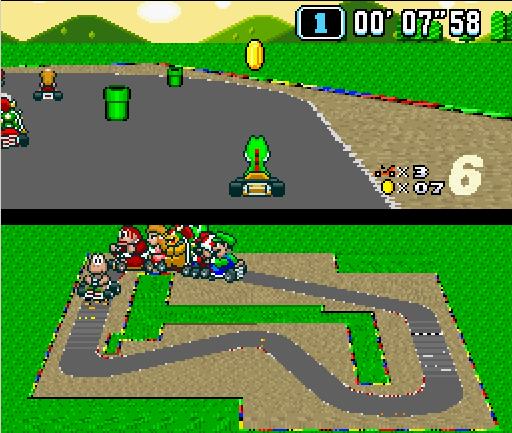
Super Mario Kart - SNES
Oh ho – I know this is going to cause the most discussion; how did I choose the SNES version over the others? Let’s recap; Mario Kart has appeared on the SNES, N64, Gamecube, DS and Wii in that order, both chronologically and in order of excellence. Each version has built upon the SNES version and on its respective predecessor in every way but in gameplay. In a nutshell, you choose a Nintendo character and race round a variety of racetracks, using some powerups and nifty driving skills. The graphics have without doubt hit a high with the Wii version, but the gameplay is flawed in terms of not allowing players to win the race fairly. For example, you dare not go into the lead on the Wii version, else you will be completely destroyed by several leader-hunting shells, ink-spraying squids and red shells. The DS version is a bit flimsy in terms of controls, and the continuous jumping method everyone seems to use when playing online is just annoying.
The N64 version is almost better than the SNES version, and I will play the N64 version more readily than the SNES version. However, the racers and maps in the SNES version are far more balanced than in the N64, and ignoring the awesome graphics of the N64, the SNES offers a far more pleasing race experience. A classic game, but Nintendo need a slap because the Wii and DS versions are random and chaotic. Clean it up, Big N.
Jetpac
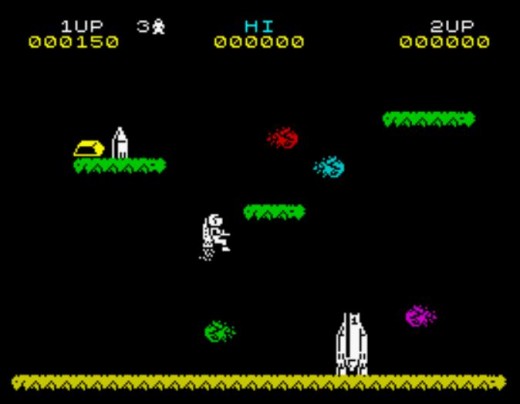
Jetpac - ZX Spectrum
The good thing about the Spectrum was that it didn’t interfere with the other parts of your life. The loading times for each game meant you had at least 5 minutes to read a book, or make a phone call, all interwoven with your gamesplaying.
Jetpac was another game released by the wonderful Ultimate company (legend has it that Ultimate became Rare), and Jetpac was the pre-quel to the much-revered Lunar Jetman. Incidentally, Lunar Jetman did not make the team because it was extremely hard, and very unrewarding. On the front of the cassette inlay, Lunar Jetman showed the lunar buggy in the game, as well as a trailer. Your Sinclair, bible to Speccy owners during the 80’s, actually went hours and hours into the game to see if a trailer exists; I think they were successful.
Anyway, back to Jetpac. You control a spaceman that has to piece together his ship, before loading up with enough fuel to blast off of the level whilst fighting off baddies. Simple? Yes, but no but yes. The bad guys differ on each level. After 4 or 5 levels, you get a different kind of spaceship (which was amazing back in the 80’s – variation? Wow!) and harder enemies.
Jetpac makes this list because it had a well-paced out learning curve. It also introduced elements present in platformers and shoot-em-ups later on. Bonus items (only points though – no power-ups), continuing gameplay, variation in enemy, and even a bit of A.I. in the enemy; those pesky rockets on about the 4th level actually hunted for you, rather than bobbing around aimlessly.
Aliens vs Predator 2
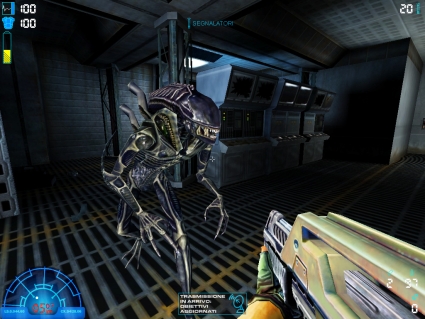
Aliens vs Predator 2 - IBM PC
The Aliens vs Predator franchise confuses me. The Alien is an unholy vision of a nightmare personified. The Predator is an entity that revels in the hunting of prey. They should meld together with little effort, yet someone or something keeps messing things up. The Aliens vs Predator film was rubbish – why isolate the whole film in the Antartic? It’s the same for AvP - Requiem, although it started going in the right direction with a semi-urban environment.
The only good thing to come out of this marriage is this game. The first game was excellent in capturing the atmosphere of the Aliens film; go into hostile environments with some high-calibre weaponry and take apart anything that doesn’t look human.
As you can imagine, the Alien and Predator films have got a large following, and the first AvP game was hailed as the best Alien game to date. There were a few places that the game could have been improved, most notably the Alien itself. If you examine the Alien in every film that it has appeared in, the most distinguishing feature is the bulk of the thing and the inhuman speed that it moves at. The alien in AVP was fast but extremely fragile-looking, so it went back to the drawing board.
AvP 2 smartened up the alien a lot, and made it look a lot heavier than the previous version. Generally, AvP 2 gave AvP a facelift, making use of shadows, lighting, sound effects and music to give the player some goosebumps prior to getting chased by a swarm of xenos. I wasn’t impressed with the Predator mode in AvP, but AvP 2 does make the Predator a force to reckon with. The Alien mode is one that you either love or hate. The original wasn’t much about anything, but the story in the second is something more decent and palatable.
Finally, multiplayer mode rocks if you like either franchise. If you have a few like-minded friends, I would recommend kitting out as marines, having someone armed with the smartgun on-point, followed up by the heavier weaponry. This results in a small but absolutely lethal killsquad, especially with the auto-aim smartgun highlighting enemies, and the rest of your team rolling in with the miniguns and pulse rifles. The Predator’s abilities are largely useless in multiplayer, so it’s mainly aliens vs humans, as it should be.
Starwing
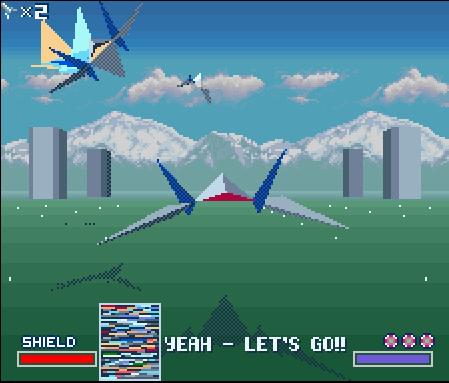
Starwing/Starfox - SNES
What game came first; Starwing or Starglider 2? One is definitely “based” on the other. Anyway, Starwing/Starfox was the first game to include the Super FX chip, a co-processor to take the workload off of the SNES and help display polygons. There were a few SuperFX-enabled games released, like Vortex and Stunt Race FX, but only Starwing made such an impact (as an aside, Vortex is a game that I wish was better, but is simply way too hard to be fun).
Again, we have a lovely "Atlantic" difference for the same game. In the UK, Starfox was already a copyrighted name so Nintendo renamed it to Starwing. Heaven forbid Nintendo spending money and buying the name for us poor Brits... :-)
Starwing is a flying shooter, much like Afterburner but with lasers, shields and different planets. You control Fox, pilot of a Arwing fighter ship. Battle through many 3D levels of enemy ships to get to the big boss Andross (hey, that rhymes!). It has a reasonable level of difficulty and a couple of secret levels to boot, and really takes hold of the 3D effects made possible by the Super FX chip. 3D plane, 3D landscapes, big polygon bosses, bombs, lasers, explosions (but not 3D though), and a fruit machine if you can find the secret area!
Yoshi's Island
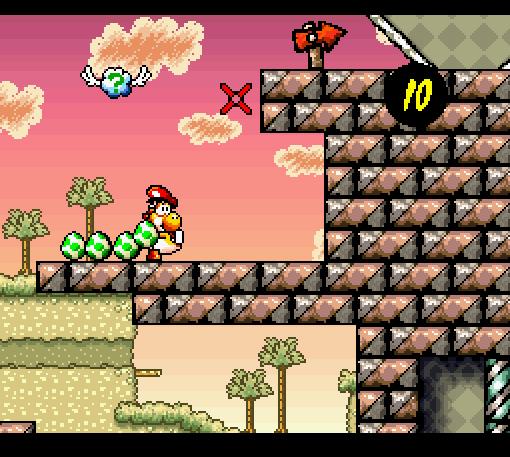
Yoshi's Island - SNES
I’ll admit that I was more Sonic than Mario back in the day (pre-SM64). I found Mario to be a little bit generic, whereas Sonic was more varied. With the advent of 32-bit and 64-bit processors, the side-scroller was fast becoming dated, so Nintendo decided to put it to bed with one final Mario game. Not just a Mario game, but the best side-scroller ever.
If you remember, Yoshi first appeared on our consoles in Super Mario World on the SNES. He was a bit of an oddity, and had limited success in Yoshi’s Cookie and Yoshi’s Safari as well as being a racer in Mario Kart. It seems that Nintendo wanted to sign off the SNES in a respectable fashion, and was aware that SM64 was on the horizon, so they released Super Mario World 2 as a Yoshi adventure rather than a Mario one.
The plot is a little weak; baby Mario has fallen onto the Yoshi’s island, so all the Yoshis decide to carry him back home. Each Yoshi carries Mario through one level, eating Shy Guys, jumping on enemies, wheels, avoiding Bow Wows jumping out of the background…the list is long and numerous. The game uses every trick and effect that the SNES has to offer, and in turn makes one of the best games ever. Yoshi can fire eggs at enemies and triggers, trying to not get hit, else losing Mario (and losing the game if the baby timer runs out).
I love it; Nintendo recently released Yoshi’s Island on the DS, but it doesn’t come close to the SNES version; the music score and effects are pale imitators to the SNES version, and the gameplay lacks the intensity that the SNES offered. It isn’t as hollow as Sonic, and not as straight-forward as previous Marios. It requires some generic platform skills and some puzzle-solving abilities as well as some nifty hand-eye co-ordination for lobbing shells accurately. There’s some tough bosses and some beautiful scenes, including a Bowser showdown which confirmed to me that this is the best platform game ever.
Chaos
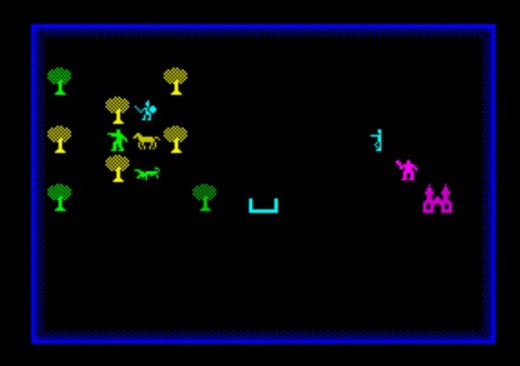
Chaos - ZX Spectrum
This game needs more recognition. You pick your wizard icon, colour, then you’re allocated a random set of spells. You then take it in turns casting a spell, then moving your creatures. Mostly, the spells are creatures; depending on their strengths, they have a difficulty of casting successfully. You can opt to cast them as illusions, which offer a 100% success rate but can be Disbelieved by your opponents and destroyed. Creating a real Dragon gives you a slight feeling of accomplishment, especially when one of your opponents tries to Disbelieve it immediately.
For a small game, it offers a massive return in gameplay hours, especially if some friends take a wizard each. The spells are very well thought-out, and there’s enough to keep anyone interested. Some people have created Window ports of this game, but I always get the feeling that if taken up, a modern equivalent of this game would be awesome. Play it on a Spectrum emulator soon.
X Wing
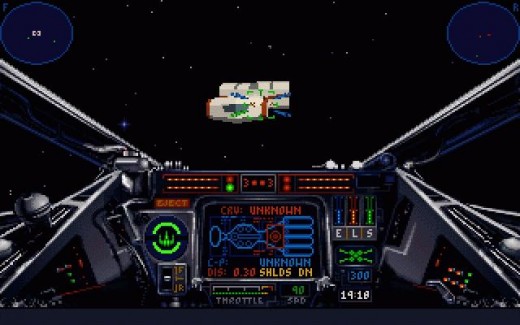
X-Wing - IBM PC
Rightly so, my dad had a better PC than I did when I was young; I was running a 386 SX40 whilst he was running a 386 DX33. I had a faster clockspeed but no floating point unit, which is essential when running applications that, say, have many 3D tie fighters, tie bombers and other ships of the Imperial Navy whizzing around on your monitor.
I love Star Wars, just like every game-playing, Chess-studying, Warhammer 40K-painting, Star Trek-watching nerd should. There’s probably something deep in my psyche that wants to be a Jedi or at least a rebel pilot, which is why I would wait with impatience for Lucas to have the same game ideas that I was having. Finally, he must have heard my innermost thought, “release the Star Wars arcade game, but pad out the graphics a bit” and I was happy.
X-Wing pits you, as a rebel pilot, against the Imperial Navy’s best in a series of missions that require you to defend, destroy or patrol. As with most things with LucasArts, they don’t mess around. The starships were awesome for the technology at the time, and the levels were challenging and fun. It had the right amount of pace to be a good shooter and a good strategy game; do you go for the fleet of Tie Bombers first or the squad of Tie Fighters and hope the capital ship can soak up the damage before you can get to them? Pretty good stuff. There were a host of sequels that expanded the scope of the original X Wing game, and they were all good.
Lemmings
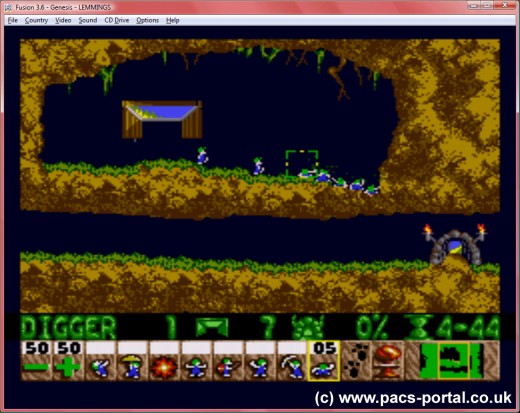
Lemmings - Everything
Lemmings is possibly the only game to be released on every format I can think of. Lemmings was also the first game I bought on my old Amstrad 1640 PC, which came on a 5.1/4” floppy disk; ah, those were the days.
If you haven’t played Lemmings, then it’s quite possible you still have your sanity intact as Lemmings threatened to shatter mine several times. The idea isn’t that simple, but is fun. You must get a minimum number of lemmings from the start to the finish. You’ll be given a number of abilities to hand out to lemmings; for example, a blocker will stand blocking the way, so all other lemmings will hit him and turn the other way, and a floater (heh heh) floats when falling rather than plummeting to its death.
The first few levels are fun, but then it gets weird. You’ll have to think about digging down levels, being creative with suicide lemmings, and just letting some of them perish in order to save the lot.
Even if you manage to get through all those mind-destroying levels, there’s Oh No Not More Lemmings to contend with, as well as a Christmas Lemmings and various user-created levels too.
Lemmings is frantic fun. Trying to figure out how to get 50 lemmings through 10 pillar with only 5 suicide bombers will tease your brain until you accomplish it. The graphics are nothing special, the sounds are annoying (especially the “oh no” when you make them all blow up) and the controls are simple and clear. This game though is probably one that will appear on every future console, as it’s near perfect in its mission to entertain for many hours.
Dragon's Lair
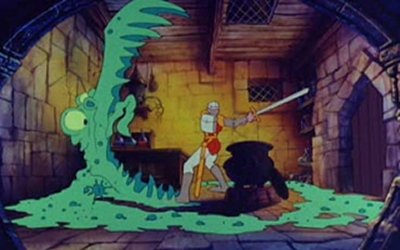
Dragon's Lair - Arcade
Dragon’s Lair verges on the experimental in the way it works. In essence, it is an interactive cartoon that jumps scenes as the player tells Dirk the hero what to do. As you can probably imagine, Dragon’s Lair had to be delivered via a huge laserdisc rather than within memory chips due to the amount of raw video data that the game demanded. Not surprisingly, Dragon’s Lair (and the very similar Space Ace) has been released on DVD, and works in exactly the same way.
Don Bleuth, of Disney fame, made sure that this was an absolute treasure to behold. And it is; I get the impression that if Manga started off with western influences, many films would look like Dragon’s Lair. It’s mesmerizing to play because it literally is a cartoon that you control. Equally, it is the hardest game that I’ve had the fortune of playing. It doesn’t allow for much margin for error, it requires almost pinpoint timing (when something flashes on the screen, you must press a direction or the attack button, else Dirk dies), and there’s little in the way of hints too. Rather than a linear path through the game, it randomly picks a puzzle for you to play. Lots of them.
All-in-all, a very unique experience and one that is well-delivered, as you would expect from someone previously connected to Disney. It did spark off a spate of “choose your own video adventure” games such as Space Ace and Firefox, but the mechanics was very limited in what it could deliver. Still, makes you wonder what the entertainment industry would be like if this way of making a game had taken off…
Space Crusade
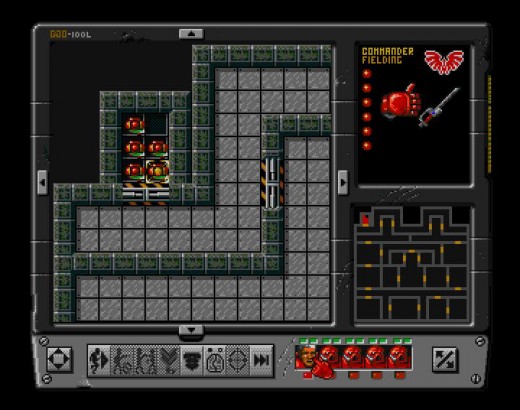
Space Crusade - Amiga
I used to have Space Crusade as a board game (and incidentally started off a hobby painting Warhammer 40K miniatures as a result). The problem with most board games is that it takes a while to set up, takes ages to pack away, and also requires someone else that is as eager to play as you are, when you are. Up steps the personal computer that suddenly doubles up as a friend-on-demand and also the friend that sets up and packs the game away.
If you’re not familiar with the world of Warhammer 40K, the whole universe is just one huge warzone. All the aliens are based on olde world races, such as orks, elders, chaos soldiers. In response, bio-engineered super soldiers have been developed, established as Chapters and set loose on the menacing aliens. In Space Crusade, you take control of 5 Space Marines belonging to one of three available chapters, each with exclusive equipment & abilities. Your mission varies, but involves searching through the corridors and rooms of a spaceship, blasting any aliens you meet. It is a turn-based affair, each team of marines moving and firing their soldiers, then the alien player moving and firing all alien troops.
Space Crusade was released on a few formats, but the Amiga had all the resources available at the time to present the game well. The game was a literal translation of a board game into a neat electronic format, handling all the boring elements such as cards, rules, and the enemy characters’ moves and attacks. As well as a 2D “top-down” view of the board, it did also offer a 3D isometric view, but was very messy and confusing.
The actual board game is a dumbed-down version of the Warhammer 40K rules, and is easy to understand without being too simple. It doesn’t go into too much depth, and spares the players from working out blast radius and cover bonuses, but it does give the player some unique abilities. Each marine can be equipped with different weapons that have special effects, so you can charge into rooms spraying machine gun fire and rockets, or send the commander in to dish out hand-to-hand slaps before the rest of your squad follows in to mop up any stragglers. In any case, the computer handles the rules, leaving the player to concentrate on strategy and tactics.
Space Crusade was a great board game that was a gateway game into the world of Warhammer 40K. Bringing the board game into the computer game market in such a slick and capable way was a stroke of genius on the part of Games Workshop, and Gremlin in turn created a classic to be enjoyed by GW fans and non-fans equally. Think Dawn of War, but more grandfather-like; slower but wiser.
Alien
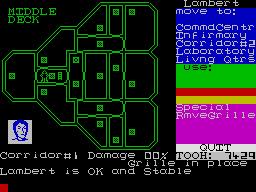
Alien - ZX Spectrum
Spooky as hell, Alien on the speccy wasn’t for the faint-hearted. Based on the film Alien, you control the crew of the Nostromo just after the alien hatches from Kane (although in this version, the alien erupts from a random member). You view the ship as blueprints, and tell each crewmember which room to go to and what actions to take. There are weapons to collect (although the alien isn’t as vulnerable to flamethrowers as you would think) and items to use. It is a good representation of the film without using too much in the way of graphics.
It’s the sounds that out you on edge. You can pick up motion trackers aand, when equipped, you hear a beeping when the alien is near, although “near” doesn’t necessarily mean “in the rooms”; you and the alien can traverse the airducts too. The alien can also start trashing parts of the ship, causing fires and damage. On top of that, the alien can just start killing the crew, obviously not good for the poor crewmember but also has a morale impact on the rest of the crew if they come across the body, causing them to refuse going into the airducts or other rooms. Finally, one of the crewmembers at the start of the game is designated “the mad android”, so sometime during the game, you’ll find that crewmembers are suddenly killed for no reason, or that someone is operating of their own accord. Nasty stuff.
There’s a few ways to win the game. The first is to kill the alien by attacking it. Not that easy, but can be done. The second is to lure it into one of the airlocks and blast it into space. The third is to collect the catbox, get Jones the Cat, set the auto-destruct and get out of the Nostromo. All three ways are pretty hard, but I personally have off’d the alien using the airlock technique. Brilliant game.
Homeworld 2
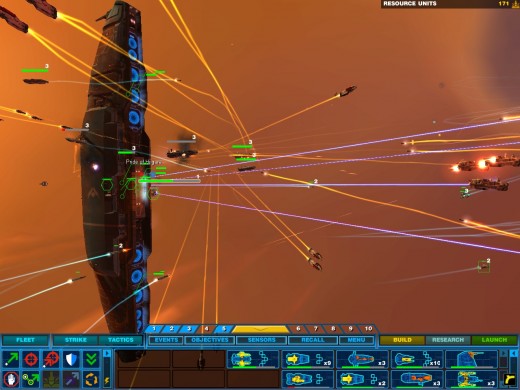
Homeworld 2 - IBM PC
Ever wanted to know what it would feel like to play art? Install Homeworld 2 and jam all the settings up. This game is beautiful, AND intense. It’s a C&C type game, set in space, with hauntingly beautiful music scores, eye-popping space-scapes, and intense space battles. I mean, simply hundreds of individual spaceships take part in huge space battles, all under your command. If you love Command and Conquer, you will fall head over heels in love with this, trust me. The missions are hard enough to cause a problem, but not enough to frustrate. A Homeworld 3 would be very much welcome (and apparently in the pipe).
Metal Slug X
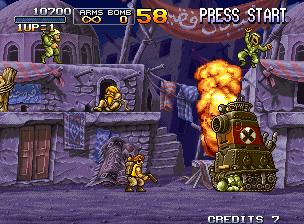
Metal Slug X - Neo Geo
Where Yoshi’s Island is the last word of the platform genre, Metal Slug is the last word in the side scrolling shooter genre. Metal Slug is a bit crafty, as side-scrolling shooters don’t need a lot of technology to work, yet Metal Slug had the full power of the Neo Geo behind it. As such, the mechanics of the game took up a little bit of the processing power, and the rest went into making it slick and tidy.
We may take graphics for granted in this HD age, but Metal Slug went far beyond what was required of a game like this. It was the attention to small details and animations that separated this to others of its ilk, such as little puffs of smoke from bombs & guns, background animals, and facial animations of the enemy. This is a game that’s easy to play but hard to complete, with some secrets and a variety of weapons to use, levels to explore & navigate, and a whole roost of bad guys to dismiss.
There’s been a few Metal Slugs previous to X; there’s not been too much difference between each one, but X seemed to be a tidier affair and thus earns its entry into this list above the others. Pure quality.
The Punisher
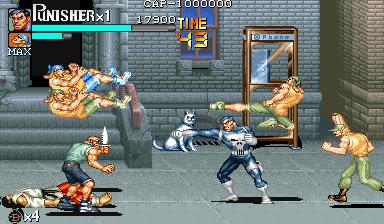
The Punisher - Arcade
There were a whole host of beat-em-ups that emulated Final Fight; walk from left to right and beat up enemies. Some of the most memorable were TMNT, Simpsons, Double Dragon and Streets of Rage. However, The Punisher bested all these for playability and graphics.
You play The Punisher (shock, gasp, surprise etc), Marvel comic book hero. You fight enemies either with your fists, hand-to-hand weapons or, in some sections, a pistol. It doesn’t make for a very exciting or original game on paper, and that’s just it; The Punisher refined every side-scrolling beat-em-up game previous to it. It was attention to detail; you can see a little bam or whack as you make contact with someone’s face, in true comic book style. The characters feel solid and react well to your button presses, and you have a special move to clear the space around you, or even a grenade to chuck at the ground to blow everyone up. In a strange way, it did what every other beat-em-up has done, but perfectly.
The Puinisher is the king of its genre and is worthy of anyone’s money. Originality scores a zero, but the game is pure perfection.
Doom 3
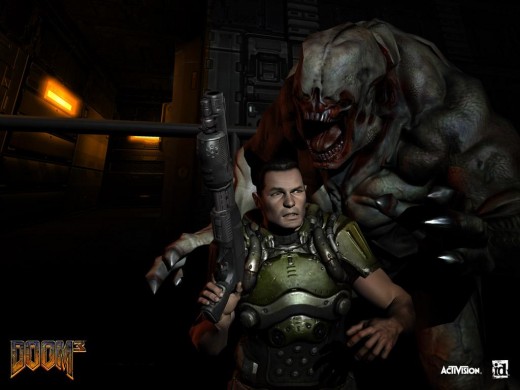
Doom 3 - IBM PC
I really struggled not to put this game in because the original Doom is already in the list, and Doom 3 is not a sequel but a retelling of the original. This game was possibly the most anticipated release ever, and the demo which ATI let leak out onto the Interwebthingy added to Doom fever.
I was also struggling whether to put the PC or the Xbox version in this list, as although the PC version plays beautifully, the Xbox version is a near-perfect port, and also leaps you more into the action from the start. The controls, always something that FPS games suffer by when on analogue sticks, actually works extremely well. However, the PC version is a more complete experience, especially armed with the right kit in your rig.
Put simply, this game is one of two that has scared me into hitting the pause button and going for a brisk walk to try and get my nerve back, and I don’t scare easy from films or games. Lighting and sound are carefully weaved together to literally put you on your seat’s edge, having more of an un-nerving effect than when the monsters actually attack. The plot is similarly crafted, with some skill into explaining the science behind Hell’s monsters, and making it feel more like an experiment gone wrong rather than “crazy magic from a biblical place”.
There is one thing that, like Marmite, makes people love this game or hate it; the torch. Due to some really dark rooms and levels, equipping the torch is a necessity, but you can only do this as a replacement to your current weapon. A lot of people complained that this made the game disjointed, but I say nay; this is a stroke of genius which further enhances the need for caution throughout the game. You can either see or shoot, not both, and this forces the player to start making tactics for when the lights go out.
The game is superb, but not groundbreaking so isn't as important as the original. Still, beats almost every other First Person Shooter out there, and that's good enough for me!
Blackthorne
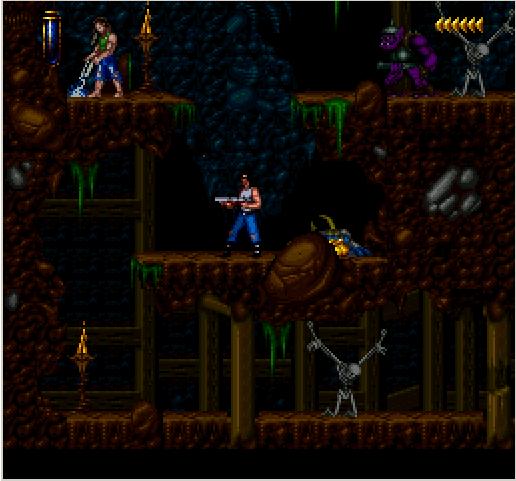
Blackthorne - SNES
Blackthorne is one of those rare gems that pop up now and again. My friend bought this one day, and a quick play on it got me hooked.
It's the usual "escape from oppression" storyline, set out as an action/puzzler. You're armed with a shotgun (which can be upgraded to fire faster later on) and jumping/running skills. There's also a few bombs, bomb bees and potions to collect and use.
For those who have a keen eye, you would suspect a Prince of Persia clone, and you'd be right; what sets this above PoP is the atmosphere, sounds and animations within the game. It's slick, moody, smooth...I could go on but it's easier to recommend it and let you find out for yourself.
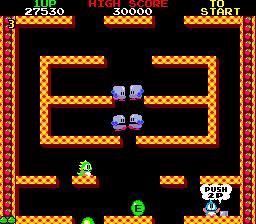
Bubble Bobble - Arcade
I love Bubble Bobble. It's the zany fun nature of the whole thing; a pair of midget dragons blowing bubbles and popping monsters, collecting food and letters in bubbles...it;s fantastic and how all computer games should be; literally, fantastic.
There's also the stranger objects to look out for, like magic candy canes that skip you on 5 levels, or candy wrappers that allow you to blow bubbles faster or longer. The music matches the game; light-hearted, funny, and memorable. The sequel Bubble Bobble Memories is also excellent, but the original doesn't give up its secrets so easily, and is therefore more of a challenge.
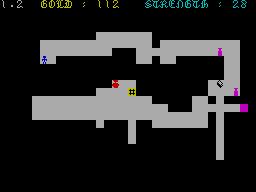
Journey's End - ZX Spectrum
In terms of RPG games, Journeys End pretty much predates everything else. Another game from Games Workshop (Warhammer 40K makers), this is a surprisingly big adventure game made up of three different sub-games.
Firstly, you find yourself in a dark dungeon. You have to explore it, looking for gold, potions (which can be beneficial or poisonous), maps, keys and eventually an exit. If you survive the traps and potions, you have to buy your fellow adventurers. Not enough gold? You can bet on the rat races to accumulate more. Finally, you set off on your quest, fighting monsters along the way.
The most amazing thing about Journey's End is that it displays elements of RPGs that are still used today. The "fog of war" used in Command and Conquer games/clones is used to great effect in the dungeon level, which is pretty amazing. Your team of adventurers are made up of stamina points, different spells, strength, special abilities, hunger...pretty much everything modern RPGs have as attributes for characters. Finally, the fight sequences are not a million miles away from the fighting mechanics behind Final Fantasy; turn-based, ranged attacks, spells, and melee combat are all available, depending on the character.
It's a real eye-opener, and quite engrossing too. I love the dungeon levels, as it has real sense of adventure about it.
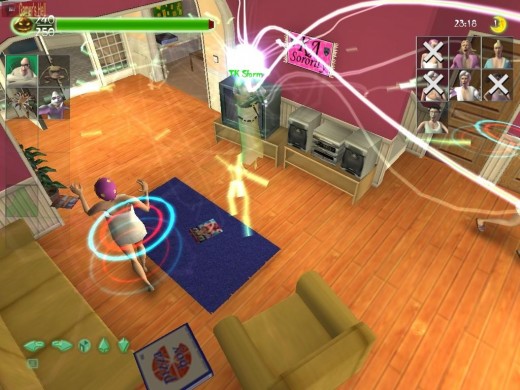
Ghostmaster - PC
This game is absolutely fantastic on the PC, but poor on the Xbox. In essence, this is a ghost game set in The Sims. You play the Ghostmaster, and your aim in each level is to use your ghosts to scare the hell out of everyone in the level. Simple? No. There are some restraints and some added factors that make this game very strategic. Each ghost needs to be tethered to an object or area before they can appear in the real world, and the available tethers depends on what kind of ghost they are. For example, a fire ghost needs to be tethered to something on fire in the level, a water one needs to be tethered to a puddle...you get the idea. As you accumulate points, you can buy additional spells for some of your ghosts. Some of the spells that you can use to scare people include vines that come out of the floor, a mass of spiders, an apparition that rips itself in half for all to see, a poltergeist that makes all objects in a room float around, a ghost that chases people, and background sounds such as thunder, chains and wailing. There are A LOT of different ways to scare people, and that is the aspect that makes this game so much fun.
The people in each level have deep-rooted fears and dislikes. Exploiting these fears can make people faint, go insane, or simply run away in fright. There are secret ghosts to find on each level too - some you can see tethered to their buried body or an object that they need to be freed from. Some are waiting for you to find them - I found one completely by accident by conjuring up a storm using strong winds, rain and thunder.
Some of the levels are delicate operations, where you must try to build up enough fright to use your ghosts BUT not enough fright that causes everyone to run off. On the other end of the scale, some levels have a few dozen people that you must scare the willies out of.
This is definitely a game to get - no question about that. There have been many rumours about a sequel, but nothing has materialised yet.
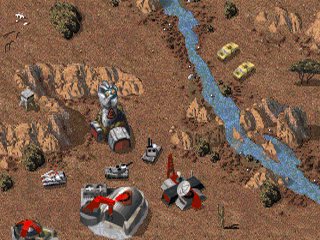
Command and Conquer - PC
I don't like Command and Conquer at all. However, it is the base used in some of the best games we've seen; Warcraft 3, Homeworld 2, Dawn of War...oh, too many to mention. C&C brought a genre to the table that worked well, and that's what is revolutionary about it. It provided the framework for people to bring a story to the marketplace without worrying about whether the format would work.
Let's have a look at the mechanics; it's a combat sim that focuses on units of infantry and vehicles rather than the individuals themselves. Incidentally, C&C Renegade will make it into the Worst Games of All Time (when I get the chance to write it). It allows development of weapons and more powerful units through power and resource gathering over time. It allows for units to be grouped using hotkeys. It allows for units to have different abilities that affect enemy and friendly units. These mechanics alone can describe about 50 well-known games already, and will explain a lot of future ones too.
C&C is as important as Doom and Mario 64; without it, the games industry would be very different.
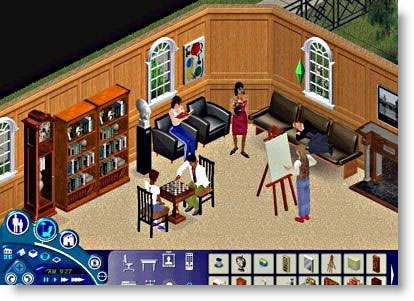
The Sims - PC
Again, not a game which I like. I class The Sims in the same vein as Big Brother; pointlessly voyeuristic in nature. However, like Big Brother, once you start getting involved, you are hooked.
The Sims allows you to simulate life, albeit within a confined space. You can build you own house, decorate it how you like, add furniture and objects for your Sim (or family of Sims) to interact with, and live life out. You can make friends, get married, break up, get robbed, die, get promoted, or get burnt to death within the same day if so desired. The graphics do the trick, the music is suitably low-key and "cheesy" - I especially like the mall-grade "Muzak" when shopping for objects and items. The format is unique since there is no real objective other than to constantly improve your Sim's life. There is a subtle "life trainer" at work, in a kind of "problem = requirement = solution" format. Problem = I was robbed. Requirement = A deterrent to being robbed. Solution = Buy a burglar alarm.
The updates and upgrades available to the game is limitless; as well as user-created objects, there are official game packs. These include Hot Date, On Holiday, Makin' Magic and even an Ikea add-on that allow you to "shop" at Ikea! Pretty good if that floats your boat. The Sims 2 has its own set of expansion packs, and the newly-released Sims 3 will undoubtedly have the same. Yes - if you plan of getting well into the Sims, make sure you have deep pockets!
I was hit by a wave of realisation when playing the Sims for about 6 or 7 days; is this a true reflection of how life actually is? Get up, go to work, come back, eat, watch TV. The need to socialise in order to improve your standing. The requirement to "study" in order to get promoted. The acquisition of material objects to improve your lifestyle/self-worth. On a deeper level, the realisation that my life might be part of a more-advanced "The Sims" simulation played out by another being, and as such inconsequential. I felt scared that life might be literally this simple. For a game to question my reality, it MUST be good!
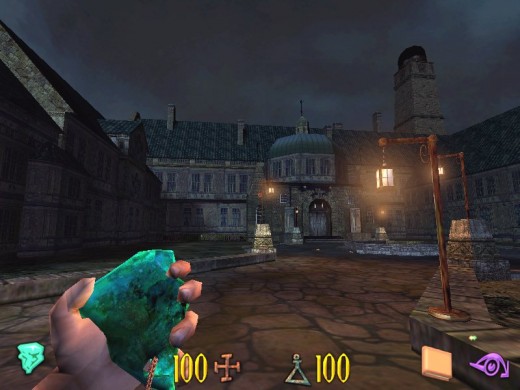
Clive Barker's Undying - IBM PC
This game is essential if you have an interest in FPS games, the occult and mysteries. Put simply, think Alone in the Dark with a Res Evil twist set in first person. You are exploring a mystery surrounding an old english family and need to discover the family's secrets. You have some spiritual powers available; the most notable and freaky is scree, as this allows you to see events that took place in your location but in the past. Cue people being hanged, ghosts, mythical beasts, poltergeist effects, voices, visions, big guns... it's an amazing game.
For the record, the new Wolfenstein is very similar to CBU, but not as good. There. I said it; sorry iD.
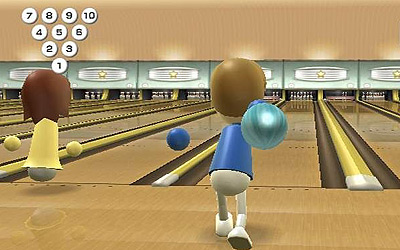
Wii Sports - Nintendo Wii
Wii Sports is possibly one of the best and most entertaining games ever devised. It's not a wild idea, but the mechanics of the Nintendo Wii console allow this to become a very unique game.
Put simply, you can play 5 different sports against friends (or the computer if you want to practise). The games are very well-presented; bowling, tennis, boxing, golf and baseball. Unlike other sports games, Wii Sports focuses on fun rather than accuracy, but there is some skill involved. The golf, tennis and bowling are superb. My personal preference is the bowling; the controller reads your actions very well and allows you to put spin on the ball.
As with the Game Boy and Tetris, Nintendo have brought back the "console bundled with a showcase game" and is a corker. A great reason to buy a Wii.
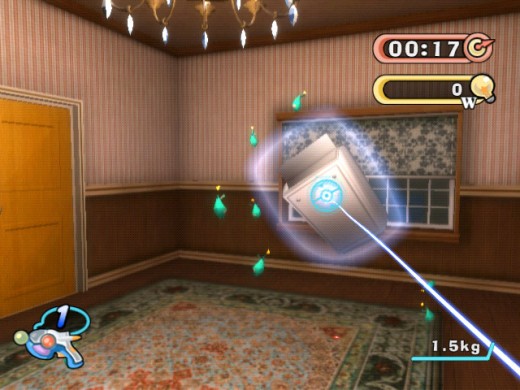
Eledees - Nintendo Wii
What a game - remember the kids gameshow Funhouse? You had to search for a number of objects whilst completely trashing the room? Remember playing it at home and getting a right-shouting at from your parents for ruining the living room? No? Must have been me then.
Anyway, the aim of the game is to point and shoot at tiny little sleepy creatures called Eledees. You can find them by moving the objects in the level, from vases to cars. Once you get to a certain number of Eledees, you can switch on certain electrical objects and charge up your gun, enabling you to move heavier objects. Some levels require you to get to a certain power level. Other require you to not make a noise. Whatever the objective, it's a hide-and-seek game in a house. Lots of fun.
Games
Retro Gaming Links
- World of Spectrum
World of Spectrum, the official world archive for the Sinclair ZX Spectrum and the largest on-line gaming center on the Internet - Classic Retro Games - Retro Gamer Magazine
Website profiling retro games, brought to you buy Retro Gamer magazine, a magazine breathing new life into classic games created by Imagine Publishing - Retro Games - Online Game Site Supporting all retro, classic and neo-classic video game formats. Nin



